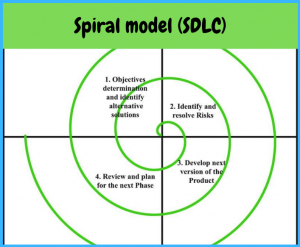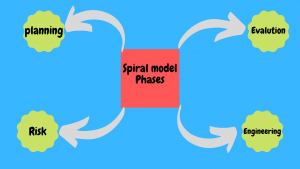Spiral SDLC
What is Spiral SDLC?
The spiral model is a system development life cycle (SDLC) technique used for managing risk which integrates the incremental modelling approach with waterfall design models. Software engineers just use spiral models and are preferred for large, expensive, and complex projects. The spiral model, when considered as a chart, makes it look like a cylinder with cycles in it. It’s a risk-driven model that implies a project’s ultimate performance is strongly dependent on the process of risk assessment. Risk analysis involves detailed know-how on each iteration. Therefore, specialized talents are required to evaluate and assess the project from time – to – time. It does seem like a model is difficult and awkward at first appearance and there’s no time to justify this solution as one of your choices. Just like every other SDLC pattern, this one has its own positive sides, in addition to its drawbacks.

Figure 1. Spiral Model SDLC
Who uses a spiral model?
One of the most exciting things about the Spiral SDLC model is that it was used by Microsoft to start new versions of Windows. The software for the Gantt chart was made using a model too. Therefore, there really is no wonder here to choose the Spiral Model large, high-risk projects that are also targeted at a broad audience. Game development is yet another business sector that takes advantage of the Spiral model. The approach allows prototyping to be created with care and rapidity. Given that the gaming industry needs to rely strongly on initial versions of the game, Spiral has become a strong bet. With the model, businesses in game development could get feedback from customers truly quickly and create a playable game that would evolve faster into equivalently able to play games.
How many phases are in the Spiral model?
Spiral model has four phases which are below.

Figure 2. Spiral SDLC Phases
Planning Phase: Requirements are composed during the stage of planning. This phase starts with collecting the attribute specifications in the baseline spiral. The invention of system requirements, element details, as well as unit-level inputs occurs during this step in the ongoing spirals as the item develops. This phase also includes trying to learn the components of the project through continual client and the consultant. At the end of the result, the code gets dispatched in the unique market.
Risk Analysis: A process is conducted during the risk identification process to assess risks and various reasons. At the final moment of a risk analysis stage, a prototype is produced. If any risk is detected and during risk assessment then alternatives are proposed and enforced. Whereby the specified circumstances and the framework conditions serve as the key measured value. In this step of the spiral model cycle, places of unpredictability that pose a risk to software project advancement should be identified. This will be accompanied by the creation of the least dangerous and most cost-effective approach, using methods like prototyping, modelling, comparison testing, analytical models, and user surveys.
Engineering Phase: After the risk analysis, real software development begins, which is always described by the comparative residual risks. For example, if the innovation process is strongly dominated by performance or user experience threats or policy capacity control risks, a genetic strategic plan is the first option where the project is written more exactly and prototypes are configured. The code is generated and verified several times till the desired outcome is reached, which then provides a low-risk ground for more developmental stages. Software is developed in this phase along with end-stage testing. Therefore, testing is done in this phase.
Evaluation phase: This phase helps the system to assess the project output signal to the deadline before proceeding to a next spiral. Upon completion of the stage, the client evaluates the outcome and offers feedback to the team. Whether this is development, prototyping, or running tests, by each stage of development the group plays through all of these stages. This is a boring procedure that has been performed several times across the entire project engineering. The SDLC Spiral Model needs to stand out in this way among many other models.
Advantages of the Spiral SDLC model.
Spiral Model SDLC is a choice for long projects where all potential dangers need to be taken into account; and where there is an early knowledge between both the team and the customer, not every stage is to be completed on a specified date. The iterative design process also facilitates corporate governance. Spiral also helps solve another significant issue for large, controlled atmosphere initiatives apart from thorough managing risk: it encourages small characteristics to be added early in the process. Additionally, while Spiral is not Agile after each stage customers can leave their information and discuss frequently with the team, ensuring the project is on the right path. The spiral model, as already noted, is a good choice for large, complex projects. The model ‘s progressive nature enables designers to break a large project into smaller parts, and handle one function at a time to make sure nothing is overlooked. Besides that, as the prototype building is increasingly done, sometimes it can be easier to estimate the cost of the whole project. The spiralling process enables feedback from customers. If the software is designed for a client then the customer can see and analyse their product at every stage. This helps them to voice discontent or make adjustments until the product is completely developed, saving time and resources for the production team.
Disadvantages of the Spiral SDLC model.
The spiral model is costly, and therefore is not suitable for large businesses. Dependence on risk analysis-Since performance of the project dependent on successful risk management, the risk management skill is needed for the personnel. The phase required for the project is often uncertain, making time management practically impossible. Thus, there will always be a danger of loss behind timetable or cost overruns. The spiral model is more complicated than most other options for SDLCs. Protocols should be closely followed for it to operate efficiently. In addition, documentation is doubled, because of the induced temperature intermediate phases. It’s probably more complicated than most other SDLC versions. Complex method. It can be difficult to identify goals, testable milestones. Increased documentation is required for large series of various stages. Time-management challenge. Because the number of steps at the beginning of the project is unclear, the calculation of time is therefore very difficult.
Read more about this